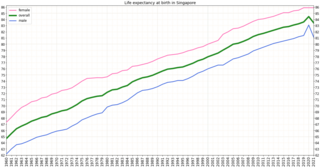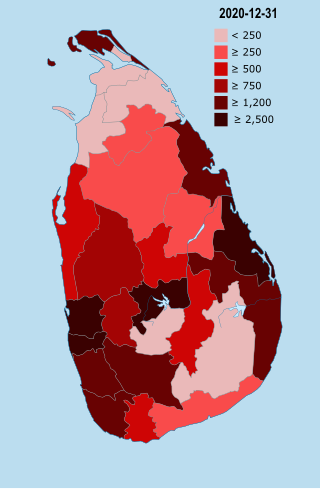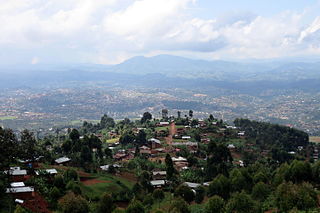Related Research Articles
Dengue fever is a mosquito-borne disease caused by dengue virus, prevalent in tropical and subtropical areas. It is frequently asymptomatic; if symptoms appear, they typically begin 3 to 14 days after infection. These may include a high fever, headache, vomiting, muscle and joint pains, and a characteristic skin itching and skin rash. Recovery generally takes two to seven days. In a small proportion of cases, the disease develops into severe dengue with bleeding, low levels of blood platelets, blood plasma leakage, and dangerously low blood pressure.

Oropouche fever is a tropical viral infection which can infect humans. It is transmitted by biting midges and mosquitoes, from a natural reservoir which includes sloths, non-human primates, and birds. The disease is named after the region where it was first discovered and isolated in 1955, by the Oropouche River in Trinidad and Tobago. Oropouche fever is caused by the Oropouche virus (OROV), of the Bunyavirales order of viruses.
In the 2005 dengue outbreak in Singapore, a significant rise in the number of dengue fever cases was reported in Singapore, becoming the country's worst health crisis since the 2003 SARS epidemic. In October 2005, there were signs that the dengue fever outbreak had peaked, as the number of weekly cases had declined and the outbreak of this infectious disease declined by the end of 2005.

African swine fever virus (ASFV) is a large, double-stranded DNA virus in the Asfarviridae family. It is the causative agent of African swine fever (ASF). The virus causes a hemorrhagic fever with high mortality rates in domestic pigs; some isolates can cause death of animals as quickly as a week after infection. It persistently infects its natural hosts, warthogs, bushpigs, and soft ticks of the genus Ornithodoros, which likely act as a vector, with no disease signs. It does not cause disease in humans. ASFV is endemic to sub-Saharan Africa and exists in the wild through a cycle of infection between ticks and wild pigs, bushpigs, and warthogs. The disease was first described after European settlers brought pigs into areas endemic with ASFV, and as such, is an example of an emerging infectious disease.

Chikungunya is a mosquito-borne alpha virus that was first isolated after a 1952 outbreak in modern-day Tanzania. The virus has circulated in forested regions of sub-Saharan African in cycles involving nonhuman primate hosts and arboreal mosquito vectors. Phylogenetic studies indicate that the urban transmission cycle—the transmission of a pathogen between humans and mosquitoes that exist in urban environments—was established on multiple occasions from strains occurring on the eastern half of Africa in non-human primate hosts. This emergence and spread beyond Africa may have started as early as the 18th century. Currently, available data does not indicate whether the introduction of chikungunya into Asia occurred in the 19th century or more recently, but this epidemic Asian strain causes outbreaks in India and continues to circulate in Southeast Asia.
In the 2006 dengue outbreak in India, cases of dengue fever were reported first from New Delhi in early September and by the end of September other states also started to report deaths. At least 3613 confirmed cases of dengue fever were reported and over 50 people died in the outbreak.

Singapore is one of the wealthiest countries in the world, with a gross domestic product (GDP) per capita of more than $57,000. Life expectancy at birth is 82.3 and infant mortality is 2.7 per 1000 live births. The population is ageing and by 2030, 20% will be over 65. However it is estimated that about 85% of those over 65 are healthy and reasonably active. Singapore has a universal health care system.

As of 2010, dengue fever is believed to infect 50 to 100 million people worldwide a year with 1/2 million life-threatening infections. It dramatically increased in frequency between 1960 and 2010, by 30 fold. This increase is believed to be due to a combination of urbanization, population growth, increased international travel, and global warming. The geographical distribution is around the equator with 70% of the total 2.5 billion people living in endemic areas from Asia and the Pacific. Many of the infected people during outbreaks are not virally tested, therefore their infections may also be due to chikungunya, a coinfection of both, or even other similar viruses.
In the 2013 dengue outbreak in Singapore, a significant rise in the number of dengue fever cases was reported in Singapore. The outbreak began in January, with the number of infections beginning to surge in April, before eventually reaching a peak of 842 dengue cases in the week of 16–22 June 2013. This figure was far beyond the highest number of cases per week in the previous three years. Although there were concerns that the rate of infection could exceed 1,000 per week, these fears did not materialize.

Ebola, also known as Ebola virus disease (EVD) and Ebola hemorrhagic fever (EHF), is a viral hemorrhagic fever in humans and other primates, caused by ebolaviruses. Symptoms typically start anywhere between two days and three weeks after infection. The first symptoms are usually fever, sore throat, muscle pain, and headaches. These are usually followed by vomiting, diarrhoea, rash and decreased liver and kidney function, at which point some people begin to bleed both internally and externally. It kills between 25% and 90% of those infected – about 50% on average. Death is often due to shock from fluid loss, and typically occurs between six and 16 days after the first symptoms appear. Early treatment of symptoms increases the survival rate considerably compared to late start. An Ebola vaccine was approved by the US FDA in December 2019.
The 2013–2014 chikungunya outbreak represented the first recorded outbreak of the disease outside of tropical Africa and Asia. In December 2013, the first locally transmitted case of chikungunya in the Americas was detected in Saint Martin. Shortly after the first case the disease began to spread rapidly throughout the Caribbean region. By the end of the year, it had spread to Martinique and Guadeloupe, with suspected cases in Saint Barthélemy. By the end of January 2014, cases had been confirmed in Saint Barthélemy, as well as the British Virgin Islands, Dominica, and French Guiana. On the basis of 4,000 confirmed cases and over 30,000 suspected cases, the Caribbean Public Health Agency (CARPHA) declared a Caribbean-wide epidemic of the virus in early May. By the end of May, four cases of chikungunya had been confirmed in Florida. By July 2014 there were an estimated 355,000 cases in the Caribbean. By August 2014, 25 Caribbean countries had confirmed at least one case. The epidemic was over by 2015.

An epidemic of Zika fever, caused by Zika virus, began in Brazil and affected other countries in the Americas from April 2015 to November 2016. The World Health Organization (WHO) declared the end of the epidemic in November 2016, but noted that the virus still represents "a highly significant and long term problem". It is estimated that 1.5 million people were infected by Zika virus in Brazil, with over 3,500 cases of infant microcephaly reported between October 2015 and January 2016. The epidemic also affected other parts of South and North America, as well as several islands in the Pacific.
In October 2013, there was an outbreak of Zika fever in French Polynesia, the first outbreak of several Zika outbreaks across Oceania. With 8,723 cases reported, it was the largest outbreak of Zika fever before the outbreak in the Americas that began in April 2015. An earlier outbreak occurred on Yap Island in the Federated States of Micronesia in 2007, but it is thought that the 2013–2014 outbreak involved an independent introduction of the Zika virus from Southeast Asia. Investigators suggested that the outbreaks of mosquito-borne diseases in the Pacific from 2012 to 2014 were "the early stages of a wave that will continue for several years", particularly because of their vulnerability to infectious diseases stemming from isolation and immunologically naive populations.

The 2019–2020 dengue fever epidemic was an epidemic of the infectious disease dengue fever in several countries of Southeast Asia, including the Philippines, Malaysia, Vietnam, and Bangladesh, Pakistan, India, Thailand, Singapore, and Laos. The spread of the disease was exacerbated by falling vaccination levels in certain areas, and by a growing population of mosquitoes, which are the primary carriers of the disease, and which are able to reproduce in larger numbers where humans have littered the environment with plastic containers, which provide an ideal breeding ground for mosquitoes. Affected countries have sought to control the epidemic through increased vaccination efforts, and through efforts to control the mosquito population.
The Central Epidemic Command Center is an agency of the National Health Command Center (NHCC). It has been activated by the government of Taiwan for several disease outbreaks, such as the 2009 swine flu pandemic and the COVID-19 pandemic. The head of the agency is Chen Shih-chung, the minister of health and welfare. The CECC is associated with the Taiwan Centers for Disease Control.

The dengue pandemic in Sri Lanka is part of the tropical disease dengue fever pandemic. Dengue fever is caused by Dengue virus, first recorded in the 1960s. It is not a native disease in this island. Present-day dengue has become a major public health problem. Aedes aegypti and Aedes albopictus are both mosquito species native to Sri Lanka. However, the disease did not emerge until the early 1960s. Dengue was first serologically confirmed in the country in 1962. A Chikungunya outbreak followed in 1965. In the early 1970s two type of dengue dominated in Sri Lanka: DENV-1 type1 and DENV-2 type 2. A total of 51 cases and 15 deaths were reported in 1965–1968. From 1989 onward, dengue fever has become endemic in Sri Lanka.

On 7 February 2021, the Congolese health ministry announced that a new case of Ebola near Butembo, North Kivu had been detected the previous day. The case was a 42-year-old woman who had symptoms of Ebola in Biena on 1 February 2021. A few days after, she died in a hospital in Butembo. The WHO said that more than 70 people who had contact with the woman had been tracked.
In the 2020 dengue outbreak in Singapore, a record-breaking number of dengue fever cases was reported in Singapore. This was part of the wider 2019–2020 dengue fever epidemic which also affected several neighbouring countries in Southeast Asia.
References
- ↑ "Jamaica declares dengue outbreak". Global Center for Health Security . 26 September 2023. Retrieved 5 December 2023.
- ↑ oldGeorgiana Gordon-Strachan (15 November 2023). "Jamaica's dengue fever outbreak shows the deadly effects of record heat". The Guardian . Retrieved 13 January 2024.
- ↑ "Holness announces 200-m programme to tackle dengue outbreak". Jamaica Observer. 10 October 2023. Retrieved 5 December 2023.
- ↑ Gordon-Strachan, Georgiana (15 November 2023). "Jamaica's dengue fever outbreak shows the deadly effects of record heat". The Guardian . Retrieved 5 December 2023.